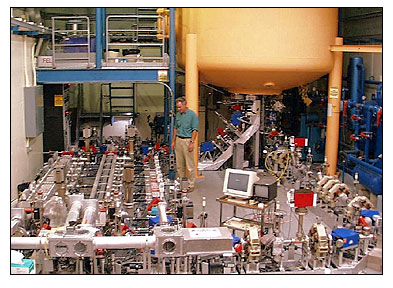ATLANTA, Jan. 4, 2006 -- By using electromagnetic waves instead of electrical current for switching, researchers have operated an optical modulator at terahertz frequencies -– an accomplishment that could one day facilitate data transmission rates in the trillions of bits per second.  The work, by researchers from the Georgia Institute of Technology, the University of California, Santa Barbara (UCSB) and NASA's Ames Research Center (Ames), represents a key step toward a new generation of optical communication systems that would be as much as 100 times faster than current technology, bringing such applications as real-time telemedicine and movies-on-demand closer to reality. While operating their terahertz modulator, the research team observed an effect that is well known in atomic physics, but until now hadn’t been seen in the semiconductor materials that comprise optical modulators.
The work, by researchers from the Georgia Institute of Technology, the University of California, Santa Barbara (UCSB) and NASA's Ames Research Center (Ames), represents a key step toward a new generation of optical communication systems that would be as much as 100 times faster than current technology, bringing such applications as real-time telemedicine and movies-on-demand closer to reality. While operating their terahertz modulator, the research team observed an effect that is well known in atomic physics, but until now hadn’t been seen in the semiconductor materials that comprise optical modulators.
“This is just one piece, but potentially a very important piece, of a very high bit-rate optical communication system for telecommunications and other applications,” said David Citrin, an associate professor in the school of electrical and computer engineering at the Georgia Tech. “The point of the experiment was to show that we can operate a modulator at terahertz frequencies, though we are still a long way from a practical device.”
Existing telecommunication systems depend on modulators to encode data onto beams of light that then can be carried long distances by optical fibers. Modulators work by rapidly changing their reflectivity, which varies the intensity of light beams passing through them. These variations correspond to the ones and zeroes that are the language of digital communication. 
The active portion of the optical modulator studied by researchers is a series of gallium arsenide quantum wells whose thickness is only tens of atomic layers. The optical beam is reflected off one side of the quantum well.
Modulators are also used as switches to reroute data streams by alternately reflecting light or allowing it to pass. But most current modulators have a drawback -- they cannot operate faster than the electronic circuitry used to control them. To boost data speeds, researchers have been seeking alternative control technologies.
“Conventional optical modulators use a voltage change to alter the properties of a material which changes the reflectivity,” Citrin explained. “Electrically switched systems are just too slow to go much beyond where we are now. But by using very high frequency electromagnetic energy to modulate the signal, the hope is that we can generate signals that have much higher data rates than what we can achieve with today’s electrical circuits.”
To gain those higher rates, Citrin and colleagues at UCSB and Ames used very high-frequency waves from a free-electron laser to control the modulator. These electromagnetic waves consist of an oscillating electric field and have the advantage of being able to move through free space without the need for circuitry.
“In principal, you can modulate light much more quickly than you can switch electrical current,” said Citrin, a theoretician who has been working as part of the team for more than a decade. “Instead of connecting the modulator to an electrical circuit, we placed it into the beam of the free-electron laser, a unique research facility at the University of California, Santa Barbara.”
Because terahertz oscillation is difficult to measure directly with existing technology, the researchers used indirect means to verify the modulation speed. Before this approach can lead to faster communication systems, the modulation must be optimized -- and the remainder of the system advanced to terahertz speeds. 
The interior of the free-electron laser facility at the University of California, Santa Barbara, the site of experiments which may one day lead to communication systems as fast as trillions of bits per second.
For example, researchers will have to develop inexpensive and convenient sources of the electromagnetic energy they use for switching. Another challenge will be to optimize the bit depth -- the difference in light intensity that represents ones and zeros. And to minimize energy requirements, they must reduce the amount of power required to operate such a system. Finally, the other components of a communications system will also have to advance to terahertz operation.
“There is a lot of interesting science going on into how the modulation works,” Citrin said. “We want to understand the issues that influence the ultimate limits of the modulation rate. If we can really understand the physics, we should be able to understand the limits not only of the modulate rates, but also the modulation depth and what are the weakest fields we might be able to use.”
Supported by the National Science Foundation, the research was reported in the Oct. 28 issue of the journal Science.
As part of the “signature” of terahertz operation, the researchers observed an effect known as the Autler-Townes Splitting. The effect is well-known in atomic physics, but the Science paper was the first report of it in the semiconductor quantum wells, which are part of the modulator. The splitting occurs when the devices are driven to operate at high frequencies, and its signature is a “double-peak” in the reflectivity of the quantum wells.
“This is an interesting physical effect that can change the optical properties of the medium from reflective to transparent,” Citrin explained. “That may have its own interest for many other applications as well.”
For more information, visit: www.gatech.edu/news-room